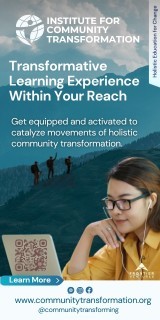Horizon One: Grass Roots Mobilization Fueling the Passion in the Pew

Lutheran Church, Missouri Synod opens a seat at the table for the people in the pew and watches its mission double.
Funding the missionary enterprise is widely viewed as a daunting task: a perpetual struggle to maintain the status quo while hoping for a bit of bottom-line growth. Amidst this environment, one well-established agency has witnessed its budget increase over 220 percent in the last seven years--from $12.6 million in 1991 to an astounding $28 million in 1998. More striking is the increase in direct-funding (gifts from an individual or a congregation towards a specific cause: a missionary, a project or a team), which has exploded nearly 600 percent over the same period--from $3.4 million to $20 million.
The budgetary figures represent only part of the picture: The Lutheran Church, Missouri Synod World Mission has opened works in 20 countries this past decade (1990-1998), equal to the number of new works begun by them in the previous four decades combined (1950-1989). When looking at the 300 percent increase in long-term volunteers over the six-year period 1991-1997, astute observers with passion for the extension of the Kingdom through the missionary enterprise are forced to take note.
And taking note, people are. Dr. Ralph Winter, founder and General Director of the U.S. Center for World Mission says, "There has never been such a mutation in missions funding in the history of U.S. mission." The Missouri Synod itself has been taken aback by the rising tide of its own success. Dr. Alan Buckman, current Director of World Areas who has been with LCMS World Mission since 1977, describes what's happening as akin to participating in "a slow-motion revolution, but one that's rapidly gaining momentum." Rev. Steve Hughey, Director for Mission Partnership and Involvement at LCMS World Mission observes that they have "grown more in the last seven years than in the first 100 years of our mission."
- What is it that the LCMS is doing right?
- Or, what is it that the Holy Spirit has brought to light in the LCMS World Mission?
- Are there transferable lessons for other denominations?
- How about the non-denominational missions' world?
Decentralize
The March-April 1998 issue of Mission Frontiers focused on "The Six Spheres of Mission Overseas." The article gave particular attention to a growing trend in mission endeavor: Congregation-Direct missions (CDM)--direct involvement of the local congregation on a foreign field, frequently without involvement of any established missions agency. According to Mike Phillips, a board member of the Antioch Network (an association linking CDM churches), churches today are simply "not content with just giving money and reading mission updates prepared by people they hardly know." Once they're caught by the vision, the people in the pew want more active involvement. Dr. Winter, as well, has recognized this "massive trend of initiative at the local, congregational level."
With this surge of enthusiasm at the local level and a somewhat deliberate attempt to bypass traditional mission structures, CDMs have drawn criticism for their advocacy of a structure that appears vulnerable to amateurism. In closing his piece representing the Congregational-Direct Missions, Phillips concedes that, without help, the movement is prone to mature "by trial and error."
It is this apparent willingness to repeat the errors made in mission history that has a number of people uncomfortable with the thought of CDM as a model worthy of emulation.
Yet, at a fundamental level, a surge in mission interest seems to be the centerpiece that the mobilization world has yearned for. Surely, it shouldn't be ignored, sidestepped or quenched. Instead, the missions industry needs to do its part channeling this energy toward productive, professional and effective missions work.
Perhaps this is the most enlightening aspect of what the LCMS World Mission has done: They have opened a seat at the table to the congregation, accommodating and fueling this enthusiasm at the local level without washing their hands of "upstart entrepreneurs" who may be a bit quick to repeat the blunders of their forerunners. Hughey sums up the story of their missions program expansion as "the decentralization of global mission," recognizing that people today are no longer willing to "just give their money and walk away." Indeed, the congregation today wants a more active part in world missions. The LCMS World Mission has welcomed this desire--even encouraged it. But instead of taking a laissez faire approach, they are channeling this local energy without shirking their responsibility to lead and foster excellence.
In their efforts to deliberately decentralize, it may be assumed that their leadership roles have been simplified, maybe even symbolic. Instead, the LCMS mission executives have found their positions growing considerably more complex. According to Dr. Glenn O'Shoney, Director of LCMS World Mission, the easier route is to maintain the more common posture of a denominational mission board--where they "make all the decisions and send all the workers." But, in a culture that has changed in some significant ways, "that means you're going to do a little bit of mission instead of a whole lot of mission," he says.
In the past, the trends in missions in the LCMS were quite a contrast to this recent move toward decentralization. In the sixties, they had some six or eight mission boards throughout the country. Then they were combined into one--the board now referred to as LCMS World Mission. With this amalgamation of numerous boards into one, there was a significant change of perception at the congregational level. That perception, according to Buckman, was that LCMS World Mission "basically 'owned' the mission program of the LCMS," though "nobody was that crass to say it." While it was not articulated as such and it was never written down, Buckman believes this consolidation of authority served to move mission vision--and responsibility--far away from the local congregation.
Today, there is a concerted effort to return this sense of vision, ownership and responsibility to the LCMS's 35 regions, nearly 6,200 congregations and two million confirmed members.
Spawn
A most conspicuous feature in this transition with the LCMS World Mission is their intentional advocacy of birthing new mission societies that are linked in varying degrees with LCMS World Mission (LCMSWM). Such marked decentralization runs counter-culture to the prevailing structure of the missions world. While leadership styles are shifting within our own culture, many mission agencies, especially denominationally-based agencies, are extremely hierarchical. The LCMSWM, instead, has advocated the creation of new mission societies, spawning legally independent organizations that are active partners in the Missouri Synod's world outreach. In 1996, when they began to move more intentionally in this direction, they had 22 affiliated agencies. Today, just three years later, they have 55 related agencies, many with a specific focus on unreached peoples.
The Tian Shan Mission Society, for example, was initially founded by three LCMS congregations for the express purpose of doing work among unreached peoples in Kyrgyzstan, focusing on the Dungang people. Legally, they are incorporated, and thus, independent. But they have a service agreement with the LCMS World Mission which notes their purpose and objectives, yet also enumerates their responsibilities--both from Tian Shan Mission Society to LCMSWM and from LCMSWM to Tian Shan.
These service agreements may also occur between regions of LCMS in North America and global regions targeted for missions outreach. One example is the LCMS Northwest Region that has a service agreement with LCMS World Mission for the missions work in the Pacific Rim. Thus, they have reduced the sometimes crippling enormity of the missions cause, replacing it with a much more tangible vision that can be readily advanced. Now, "they're not talking about 60 different missions locations, but primarily about one," O'Shoney says. The district essentially owns the work in that region. Upon furlough, the missionaries focus on visiting churches in that region, further cementing this bond and demonstrating that local churches, regions, even individuals can make a difference in a specific region of this Great Commission.
Such a model of deliberate decentralization may seem structurally vulnerable to amateurism. Actually, rather than heading up projects of their own initiative, these young societies have specialized in short and long-term volunteer service to the church-planting work of permanent, career missionaries. The LCMS World Mission board, O'Shoney says, has maintained its right to say, "What you want to do does not fit into our strategy and our direction. Therefore, we will not partner with you."
Such an approach has resonated well with the Missouri Synod's Lutheran community. Organizationally, their denomination views the congregation as the center of authority--property, for instance, is owned by the local congregation, not the Synod. In their view, the Synod exists because the local congregation does, not the opposite.
Certainly, the movement towards the creation of these agencies was not chosen because it is an easier route; in fact, according to O'Shoney, "it is much harder to work with all these organizations and all these people." The benefits, though, speak for themselves. They are doing a lot more mission. Maintaining and educating this multitude of relationships may be taxing, but it is a small price of entry to a great number of new mission fields.
While the results thus far are genuinely encouraging, they are only first fruits of what may be in store should this trend continue. Some prospective workers have yet to set foot in the field; others have, with special training, been on initial, exploratory trips. Some are involved in training on the North American continent; others are doing missiological training on the targeted field--the norm for the long-term volunteer.
At Concordia University, St. Louis campus, there are today fifteen students who recently returned from volunteer service, completing seminary training in preparation for career appointments. This particularly exemplifies how the LCMS model of mobilizing for missions has not yet had ample opportunity to bear fruit in the category of career appointments. The intentional advocacy of spawning mission societies began as recent as 1996 and many of these long-term volunteers have yet to return from their first term.
The exploratory trips done by prospective missions workers have been one great way to ferret out what Hughey concedes is "the biggest problem in the trend towards decentralization": bad missiology. The surest way they've found to demonstrate the complexities involved in cross-cultural missions is for them to see first-hand. According to Hughey, "the more people know about a culture and about the situations, and about how difficult it is to start new work, the more supportive they can be." Upon return, he has found those without any formal training much less hasty to get "on the field" and much more understanding of the LCMS World Mission's recommendation of two years of language acquisition and acculturation prior to active steps towards church-planting.
With the longer-term volunteers (usually one or two years), much of the training happens on the field. It is significant that the transition from volunteer to career service entails a formal shift, with the career worker yielding more directly to LCMS World Mission's board (as opposed to any of these newer societies). In this regard, the pattern has hints reminiscent of OMF's and other major agencies' policy, years ago, where apprentice missionaries were confirmed for career appointments only after a successful stint in cross-cultural service. Both the long-term volunteer and the apprentice or "junior" missionary provide a safety net or a proving ground prior to the deep and expensive investment in career service. Both models allow for a genuine sense of success for both parties. For the worker, he has "completed" his first term. And the agency has received help to advance the field-based objectives of permanent career workers.
For O'Shoney, the apprentice model has worked particularly well with what may be the weakness of the emerging generation. "We think that the young person today is not ready to jump into career missionary service," he says. LCMSWM's model has given these candidates an opportunity to serve, in a genuinely beneficial way while confirming (or reconsidering) their personal call to career missionary service. LCMSWM estimates that at least one in five volunteers will inquire further for career opportunities.
Invest
Perhaps the most striking component in the LCMS story is the phenomenal growth of its annual budget. At first glance it may appear inexplicable, short of full credit going, appropriately, to the Holy Spirit. Yet the Lutherans have felt the pulse of this generation's passionate evangelicals: evangelicals who are willing to stand, in tangible, monetary ways, behind the causes that they believe are a reflection of Scripture.
In the past, according to Hughey, LCMS operated on an older, prevalent model of mission structure. He gives the simplistic, though illustrative description: "It was essentially pray and pay." Under this structure, missions executives were not particularly interested in any form of active partnership. Certainly, they wanted the prayers of the congregation, and they could not operate without their financial support. Beyond that, the congregation was essentially on its own. If they were giving and praying, they were given a bill of clear conscience to carry on, at will.
Today, the LCMS congregation is an active participant, encouraged to be involved at various levels. Hughey's office has given the congregation a progressive series of specific options. A number of opportunities for involvement are given under the following categories: Learn, pray, give, tell, send, go and celebrate. Even their Sunday school curriculum has been infiltrated with mission vision. According to Hughey, they have come to emphasize that "this mission is God's mission," and He has given us an opportunity to be a part of it.
With specific attention to the pattern of giving, LCMS World Mission has shown keen insight into the mindset of today's giver. This donor, generally speaking, is given to a new line of thinking. Perhaps a look at Wall Street will illustrate the point. When the Dow plunged 280 points on August 21 (and as it's fluctuated ever since), more people than ever took a prolonged look of concern. In part, this is due to the fact that, according to The New York Times, almost half of all American households have direct ownership of stock. This is nearly a 100 percent increase in the past ten years alone. Americans see themselves as investors today. This transfers, quite readily, to the world of missions. The congregant today views himself as something akin to an investor as well. As such, he is less likely to be content by giving liberally to a national headquarters with no discretion as to how the money will be spent. More relevant to the investor analogy, he has no way to measure his "return" on the investment. However intangible (or sometimes inappropriate) it might be to attempt to measure missions returns, the giver today wants to see what he stands behind. Whether it is an individual, a family, a project or a team, all provide more assessable results than national headquarters.
When the LCMSWM growth pattern is broken down, it powerfully illustrates this shift toward a more intentional investor. As stated above, the total budget of LCMS World Mission ballooned more than 220 percent over the past eight years. Yet, it is the story of direct funding that tells a more dramatic story. The 600 percent in this category over the same period now accounts for nearly three-quarters of the total budget. Weekly offerings, formerly the backbone of the denominational missions program, have actually decreased over this eight-year period--both as an absolute number and as a part of the whole.
The giver today, Hughey says, is simply "not willing to give their money and just sort of walk away." To one degree, this limits the liberty that LCMS World Mission has for using the money. Yet, this loss of liberty for how to use a particular dollar has enabled the initiation of 20 new works this decade, equal to the total number of new works in the previous four decades combined. This is liberating indeed, especially when viewed from the perspective of the previously unreached people where a church has been planted.
Essentially, LCMS World Mission is becoming a denominationally-based faith mission: grounded on the faith commitments of individuals and churches towards specific causes and missionaries. They are a pragmatic legitimization of the faith mission structure for a new generation of missions work. Beyond the satisfaction of such confirmation, faith missions outside of denominational boundaries have a good bit to glean from the Missouri Synod's story.
Partner Steve Hughey is focused on working towards establishment and maintenance of partnerships for new LCMS missions work. Frequently, as noted earlier, these are the linking of congregations for the formation of a mission society that then partners with LCMS in a particular endeavor. Having found congregations to be better educators than the Synod, they encourage congregations with more experience to link with younger congregations who are timid as to how to step forward in missions involvement. This, too, reflects a shift in congregational dynamics. Hughey recognizes that congregations are more inclined to emulate other congregations that they respect rather than receiving advice from denominational leadership which they know much less of.
As these congregations team up for the establishment of mission societies, the role of LCMS World Mission is still active. While their decentralization has changed the tenor of their involvement, the denomination remains active, and is now received in a new way. But the partnerships have contributed to an accelerated maturity of the home church. Such estimates are rough, but Hughey believes that this involvement accelerates the growth of a congregation by five years. He recognizes a truth that seems strangely Biblical: "A church that is alive and well will be involved with mission."
This new emphasis on partnership has taken some unexpected forms, illustrating the complexity of the missions task. Most recently, 13 LCMS congregations have formed a partnership with Sudanese churches to reach Sudanese refugees in camps in Ethiopia and Kenya. Such partnerships open a world of complexities, a risk of creating dependency and an added element of sophistication necessary to do bi-cultural missions outreach (see Downs, page 30).
But the potential benefits may well justify wading into these less-charted waters.
The LCMS World Mission has fostered the initiative of the local congregation, yet it hasn't left them unattended. It has decentralized, but has not ceased to lead. Their leaders have felt the pulse of how people want to give--and they have reaped a harvest.
In essence, Buckman observes, they have shifted from the role of management to that of leadership. In doing so, they are "vision-casters" whose "greatest commodity is hope."
And hope of this nature, it has been written, does not disappoint.
They are not disappointed.







comments